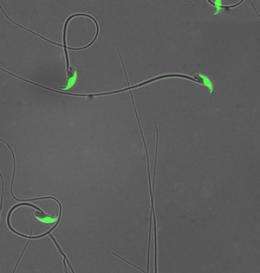New research shows potential for a male contraceptive

Researchers have known for more than half a century that sperm is able to fertilize an egg only after it has resided for a period of time in the female reproductive tract. Without this specific interaction with the female body, the sperm is incapable of producing offspring. But until now there was very little understanding of what changes occur within the sperm that suddenly allows it to fertilize an egg.
In the Journal of Proteome Research, Rensselaer Polytechnic Institute Assistant Professor of Chemistry and Chemical Biology Mark Platt reveals the molecular-level changes that occur within sperm after it enters the female reproductive tract. His findings provide important clues into the still-mysterious process of capacitation, the process by which sperm acquire the ability to fertilize an egg, including why some otherwise healthy males might encounter fertility issues. His research may also offer insight required to develop an entirely new contraceptive, even a male version of the birth control pill.
“Much has been done to understand capacitation, but with the tools that we have within the lab we can now identify how specific sites on individual proteins are modified during this process,” said Platt. “With this knowledge we can develop a deeper understanding of the molecular mechanisms required to provide sperm with fertilizing competence.”
“Based upon some of our additional work, a few of these sites appear to be essential to carrying out the process of capacitation,” Platt said.
Phosphorylation can be thought of as a light switch, which can be used to turn on or turn off a step in the chain of reactions, known as a signal transduction cascade, that leads to capacitation. Just like the initial flicking of a light switch quickly moves electricity through the wires to turn on a lamp across the room, phosphorylation provides the initial trigger that moves a cellular signal through the cell that turns “on” its ability to fertilize an egg. According to Platt, by interfering with a just a single site of phosphorylation, scientists could entirely switch off the fertilization process. It is this ability that has the strongest potential for the development of a novel contraceptive.
“If phosphorylation on a particular amino acid is absolutely required for sperm capacitation, a drug could be developed which prevents phosphorylation from occurring at that specific site, thereby preventing the entire capacitation process,” Platt said. This turning off of the phosphorylation switch could then prevent fertilization entirely.
“These applications are currently hypothetical at this point, but the implications for contraceptives resulting from this research are promising,” he said. He noted that there could be several different options that could be developed using this and future research, including a drug for males that specifically targets the individual sites of protein phosphorylation in the developing sperm or a novel spermicide that prevents capacitation from occurring in sperm residing in the female reproductive tract.
In addition, the research provides important insight into male infertility. “Certain types of male infertility could be caused by a mutation of a single amino acid on a critical protein that prevents the sperm from ever undergoing the capacitation process,” Platt said. “If you could correct that specific mutation or design a drug which mimics phosphorylation on that particular amino acid, for example, you might be able to improve fertility.”
To locate the specific site of phosphorylation, Platt and his colleagues first induced capacitation in sperm. Proteins from the capacitated sperm and proteins from a non-capacitated population were then extracted and digested into smaller segments called peptides. Using tandem mass spectrometry (MS/MS), an analytical technique utilized in his laboratory, Platt was able to determine the amino acid sequence of each peptide and to determine where each was phosphorylated. By comparing the phosphorylation status of the samples, Platt and his colleagues were able to identify 55 specific sites whose level of modification changed as a result of the capacitation process.
Source: Rensselaer Polytechnic Institute















